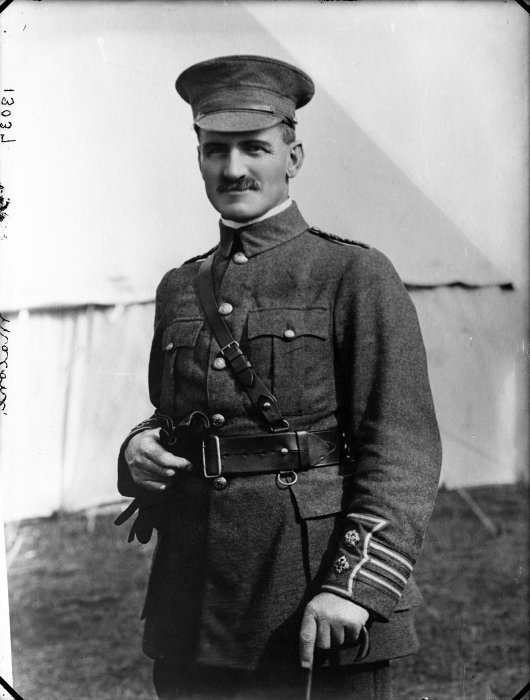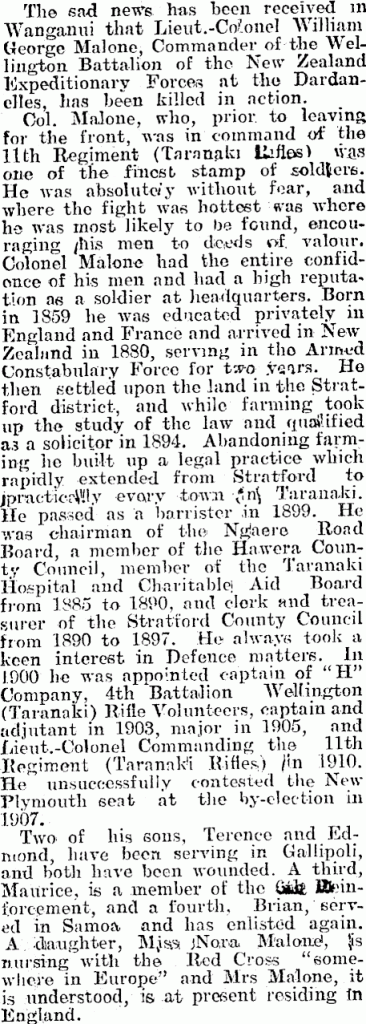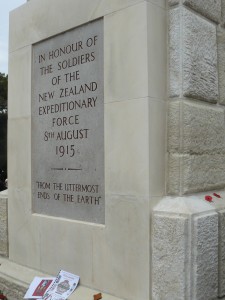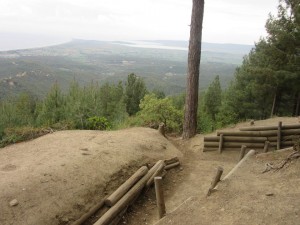The New Zealand Collection is located on the second floor of The Central Library. Each ‘This Week in History’ post is associated with a display in the NZ Collection and uses available databases and the library collections to illustrate and provide additional information.
Wellington Battalion captures Chunuk Bair – 8 August 1915
This year along with the many other 100th anniversary commemorations occurring we pay tribute and remember the many soldiers that lost their lives in the battle for Chunuk Bair. On the 8th August there will be a dawn service at the Wellington Cenotaph, 6.45am–7.45am organised by Wellington City Council to remember the huge losses that took place 100 years ago.
The name ‘Chunuk Bair’ means many things to New Zealanders, national pride, sorrow at the loss of so many lives and anger. The attack began well on the 6th August 2015 with The New Zealand Infantry Brigade and Māori Contingent clearing the way. Progress was made but there were delays which meant that the troops and equipment were not in place at the planned time to continue on and attack the summit. Lieutenant-Colonel William Malone was the commanding officer of the Wellington Battalion and for the days leading up to the battle Malone’s troops were digging in trenches below the peak and preparing to attack early on the 8th August.

Corrie, Frank Reginald, d 1915. Trooper Frank Reginald Corrie of Wellington Mounted Rifles, at Chunuk Bair, Gallipoli, Turkey, during World War I. Williams, Charles Athol, 1899-1990 : Photographs of Te Aute Station, Mangakuri Station, the Williams family, and Gallipoli Peninsula in Turkey during World War I. Ref: PAColl-0184-1-006. Alexander Turnbull Library, Wellington, New Zealand. http://natlib.govt.nz/records/23123267
The Wellington Battalion occupied the summit before dawn on 8 August. With sunrise came a barrage of fire from Turks holding higher ground to the north. A desperate struggle to hold Chunuk Bair ensued. It was not until after dark that the Otago Battalion and the Wellington Mounted Rifles arrived to reinforce the 70 Wellington Battalion men (out of 760) who were still holding the line. Malone had been killed by an Allied shell at about 5 p.m. The New Zealanders were relieved on the night of 9/10 August by British battalions, but these quickly succumbed to a counter-attack led by Mustafa Kemal, who was to become the founding President of Turkey.
(From “Today in History page at nzhistory.net.nz.”)
Lieutenant-Colonel William Malone died alongside the many others wounded and killed during the battle and is remembered as a leader who fought for the welfare of his men. A famous quote of his came when he received an order from his superior, Brigadier-General Johnston that he did not agree on and it is alleged he said “We are not taking orders from you people… My men are not going to commit suicide.”

Lieutenant Colonel William George Malone. McAllister, James, 1869-1952 :Negatives of Stratford and Taranaki district. Ref: 1/1-012824-G. Alexander Turnbull Library, Wellington, New Zealand. http://natlib.govt.nz/records/22789124
Many New Zealand papers carried this notice following William Malone’s death at Chunuk Bair.

Retrieved from Wanganui Chronicle , Issue 20434, 13 August 1915, Page 8 from Papers Past
In the New Zealand Collection I work with two people who have been fortunate to visit Chunuk Bair, one as a school student on a history trip and the other who went this year to the 100 year commemorative service. Here is Alison’s photo of the Chunuk Bair memorial taken on the 25th April this year, and a view of the trenches at Chunuk Bair looking back towards Suvla Bay. She found the Chunuk Bair service very moving and poignant. Alison was amazed that so many of the trenches were still visible and was particularly moved on seeing the magnificent view over the Dardanelles from the top. So poignant as you could plainly see why it was such a sought after objective in the Gallipoli campaign and that it was only held for three days.

While looking for information on this battle I looked at the Auckland Museum Online Cenotaph where you can access information on World War 1 Soldiers. As an example here is the page for William Malone. On the online version you can place a virtual poppy on the cenotaph next to a soldiers name and it also lists the sources used to find information which are good starting points for your own family research as well.
Commonwealth War Graves Commission. A search here for William Malone shows his grave as the Chunuk Bair New Zealand Memorial which is one of four memorials erected to commemorate New Zealand soldiers who died on the Gallipoli peninsula and whose graves are not known. This memorial has over 850 names.
To view a digitised World War One Military personnel file you can search by name on the Archives New Zealand ARCHWAY site. Click here to see William Malone’s digitised army record.
The New Zealand Electronic Text Collection is a digitised collection of significant New Zealand and Pacific Island texts held by Victoria University of Wellington. The texts are freely accessible to all researchers and you do not have to have an affiliation to Victoria University. You can access war histories and a search using Chunuk Bair will get you a long list of resources that you are able to read online.
From the library collection you can read the war diaries and letters of Lieutenant-Colonel W. G. Malone and others about Chunuk Bair and the Gallipoli campaign.
 No better death : the great war diaries and letters of William G. Malone / edited by John Crawford with Peter Cooke.
No better death : the great war diaries and letters of William G. Malone / edited by John Crawford with Peter Cooke.
“Perhaps the greatest leader of men during the Gallipoli campaign, Lieutenant-Colonel W. G. Malone was commanding officer of the Wellington Battalion of the New Zealand Expeditionary Force at Gallipoli. He is probably the best-known individual from that ill-fated campaign, a result both of his humanity and his superb leadership, which culminated in the successful assault on Chunuk Bair on 8 August 1915. Malone was killed later that day.’No Better Death’ reproduces Malone’s impressive and often moving correspondence and writings, as well as many striking photographs generously provided by Malone’s descendants. Malone was a gifted writer and a keen observer, and his letters reveal a shrewd military intelligence and genuine care for his men. Above all, this is a story of valour and fortitude under the enormous pressure of being responsible for the lives of many others. It is also the story of a man who had an unbounded love for his family, and constantly drew on the reciprocity of that love to pull through and overcome the frustrations, fear and life-threatening situations he was forced to endure. Malone’s descendants have subsequently served their country with honour, and their stories are also recorded in the book.” (Syndetics summary)
Man of Iron : The extraordinary story of New Zealand WWI hero Lieutenant-Colonel William Malone
“The first biography of one of New Zealand’s best known First World War soldiers.” (Syndetics summary)
 Gallipoli : a guide to New Zealand battlefields and memorials / Ian McGibbon.
Gallipoli : a guide to New Zealand battlefields and memorials / Ian McGibbon.
“Gallipoli is one of the most significant sites in the story of New Zealand’s First World War – a symbol of great sacrifice and camaraderie, and the heart of ongoing Anzac commemorations. Gallipoli: A Guide to New Zealand Battlefields and Memorials is the indispensable handbook to the history and geographic features of the campaign for a modern, general readership. Easy-to-follow and highly illustrated, it introduces the battlefields, cemeteries and memorials, detailing the stories behind each and offering historical overviews of New Zealand’s involvement more generally. The perfect introduction to New Zealand’s Gallipoli.” (Syndetics summary)
Chunuk Bair [videorecording] / screenplay by Grant Hindin Miller ; directed by Dale G. Bradley; produced by L. Grant Bradley.
“The tragedy of New Zealand’s experience at Gallipoli is re-told in this historical story. New Zealand’s Wellington Regiment, new to warfare, shellshocked and exhausted, are ordered by their British Generals to take Chunuk Bair. For three days they battle their way to the ridge above. Blinded by a vision of glory and devotion to honour, the Regiment’s Commander pushes up the ridge to take the high ground. Outnumbered by the Turks the New Zealanders find themselves cut off and without supplies. Courage, determination and humour keep them fighting until what was to be their salvation becomes their final nightmare” (Container)
 Gallipoli : the Dardanelles disaster in soldiers’ words and photographs / Richard van Emden and Stephen Chambers.
Gallipoli : the Dardanelles disaster in soldiers’ words and photographs / Richard van Emden and Stephen Chambers.
“Presenting more than 150 never-before-published photographs of the campaign, many taken by the soldiers themselves, together with unpublished written material from British, Anzac, French and Turkish, including eyewitness accounts of the landings, this is an unrivalled account of what really happened at Gallipoli. Van Emden’s gripping narrative and lucid analysis of Churchill’s infamous operation, compliments Chambers’s evocative images, showing how the rapid spread of diseases like dissentry, the lack of clean water and food, the tremendous losses on both sides affected morale, until finally in January 1916, in what were the best-laid plans of the entire disastrous campaign, the Allies successfully fooled the Turkish forces and evacuated their troops from the peninsula with no additional casualties. Leading First World War historian Richard van Emden and Gallipoli expert Stephen Chambers have produced an entirely fresh, personal and illuminating study of one of the Great War’s most catastrophic.” (Syndetics summary)
 Gallipoli : the New Zealand story / Christopher Pugsley. “Gallipoli is perhaps New Zealand’s most enduring myth, our ‘finest hour’, a bitter, bloody and tragic campaign in which 2721 young men lost their lives of the 8556 who fought there. The campaign is glorified in our observance of Anzac Day, but the true story of New Zealand’s involvement has never been comprehensively told. Army historian Christopher Pugsley, an expert in the campaign, has now collated his extensive research and interviews with survivors to provide a narrative which takes into account every aspect of Gallipoli and its impact on both the New Zealanders who fought there and on the country that sent them. GALLIPOLI – THE NEW ZEALAND STORY provides the first major evaluation of one of our most important historical events, and many decades after the battle, strips bare the myth of Anzac and does justice to the reality of that epic campaign.” (Syndetics summary)
Gallipoli : the New Zealand story / Christopher Pugsley. “Gallipoli is perhaps New Zealand’s most enduring myth, our ‘finest hour’, a bitter, bloody and tragic campaign in which 2721 young men lost their lives of the 8556 who fought there. The campaign is glorified in our observance of Anzac Day, but the true story of New Zealand’s involvement has never been comprehensively told. Army historian Christopher Pugsley, an expert in the campaign, has now collated his extensive research and interviews with survivors to provide a narrative which takes into account every aspect of Gallipoli and its impact on both the New Zealanders who fought there and on the country that sent them. GALLIPOLI – THE NEW ZEALAND STORY provides the first major evaluation of one of our most important historical events, and many decades after the battle, strips bare the myth of Anzac and does justice to the reality of that epic campaign.” (Syndetics summary)


